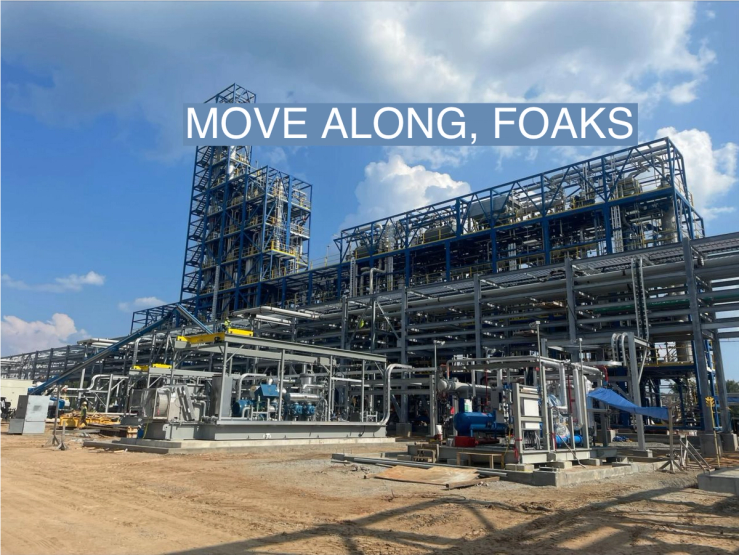The Scene
Jimmy Samartzis picked a hell of a time to launch an experimental alternative jet-fuel company: May 2020, in the heat of the pandemic, when the global aviation industry was shutting down.
The CEO of LanzaJet grew the firm out of LanzaTech, which in the 2010s developed a process to capture industrial emissions and turn them into ethanol. Scientists there later took the ethanol a step further, turning it into low-carbon jet fuel. After years of R&D, they were confident in the technology, and its cost. But only if they could manufacture it at large scale — and that was too risky a bet for most infrastructure investors.
That problem is a familiar one. Many climate-tech startups have flourished in recent years, tapping venture capital investors eager to spot the next climate “unicorn.” But as these firms mature, they struggle to raise enough money to go from lab to factory. It’s a major bottleneck in scaling up climate solutions, and a big reason why global climate tech investment is about a third of where it needs to be to reach net zero by 2050.
“There’s a lot of companies that have raised $20-50 million in their whole life, now having to do a single project that’s worth at least that same amount,” said Mario Fernandez, a senior investor at the Bill Gates-backed firm Breakthrough Energy.
Fernandez, who leads Catalyst, a special unit focused on bringing innovative climate tech to commercial scale, started with LanzaJet, which has come farther than most climate tech ventures in crossing that perilous funding gap. A $50 million grant from Breakthrough allowed the company to begin building its new factory, which is due to start production in Georgia next year. LanzaJet’s experience, in turn, informed Breakthrough’s strategy for bridging the “valley of death” between pilot- and commercial-stage facilities, which it laid out in a report this week.
Tim’s view
The money that climate tech needs to scale isn’t just bigger, it’s of a different character. Venture capital is good for startups because it has a high risk tolerance, willing to strike out most of the time for the chance to hit a rare home run. But that makes it expensive: VCs want to own a juicy chunk of the companies they back, and tend to write smaller individual checks.
The types of private equity, banks, or infrastructure investment firms that would typically back a big factory offer more money at better terms, but with a far lower risk tolerance. They’re horrified by the “move fast, break things” startup mentality. Their questions are less about a company’s technology itself, but about supply chains, construction permits, and long-term contracts with buyers. Developers of renewable-energy projects, like utility-scale wind and solar farms, have by now been around long enough to have passable answers. But for the most part, investors say, execs of more innovative climate tech firms don’t. The biggest obstacle to scaling climate tech, in other words, isn’t money per se, but a lack of project-development skills.
Commercialization of new technologies “is the single riskiest dollar” for an investor to put in, said Scott Jacobs, CEO of the sustainable infrastructure investment firm Generate Capital. “There’s almost nobody willing to do that, because it’s a terrible investment most of the time.”
The exceptions are firms like Breakthrough that are able to give philanthropically alongside their traditional investing, and government agencies like the U.S. Energy Department’s Loan Programs Office that offer grants and below-market loans. But even Breakthrough expects its grants to be a prelude to future equity investments with normal return expectations, and the LPO, although sitting on an unprecedented pile of billions thanks to Biden-era legislation, is slow and cumbersome. There’s no way to reach the trillions that are needed without much greater private investment — and no way to get those investors interested unless climate tech execs can learn to talk their language.
LanzaJet figured that out, and has buttressed its Breakthrough grant with investments from large corporations with an interest in low-carbon jet fuel, including the Japanese industrial giant Mitsui, British Airways, and Shell. The most important thing, Samartzis said, was to keep the company narrowly focused on bringing down the cost of transforming ethanol to jet fuel. That meant not attempting to get involved in the upstream ethanol production process, or attempting to reinvent factory hardware that’s the same as what you’d find in any other jet fuel refinery.
“You’re doing a lot of things that are new,” Samartzis said. “So you need to create some limits on what is new.”
Breakthrough won’t touch projects that don’t have a clear plan to eliminate the “green premium” on their product, Fernandez said. He also urges companies to lock in long-term purchasing agreements with customers, to put investors at ease about the market. In the case of aviation fuel, that was a challenge, because airlines typically buy fuel months, not years, at a time. It took some prodding to change that mentality, he said: “We’re having to teach other industries how to buy these products in a different way.”
The Breakthrough report recommends companies drive a tough bargain on construction contracts, including clauses that shift much of the liability for delays and cost overruns onto contractors. They also need to lock in reliable contracts to supply raw materials and clean electricity (“It’s not worth investing in a climate project that negatively impacts the environment,” the report warns).
Finally, the report recommends that companies build flexibility into the prices they offer for long-term customers and not lock themselves into an offering that may turn out to be unprofitable if underlying costs change. That’s the situation that recently doomed Ørsted’s offshore wind farms in New Jersey and NuScale’s advanced nuclear power plant in Utah.
The View From Boston
Boston-based private equity firm Spring Lane Capital is working to narrow the valley of death with a two-day boot camp called Developer U that trains climate tech execs on the fundamentals of how to finance a project, get regulatory approval for it, and manage the “hard-hat crowd” that will actually build it.
“When you go and informally talk to all the climate tech accelerators, incubators, and nonprofits, there is virtually zero focus on project development,” said Sean Sandbach, the firm’s head of capital formation and ESG. “There’s a huge gap in what they understand.”
Room for Disagreement
LanzaJet isn’t out of the woods yet, having not yet reached profitability. That means locking in more customers. According to Jacobs, governments aren’t doing enough on that front, and are too focused on giving grants and loans to individual projects. “Really, they should be stoking demand,” he said, by channeling public money into more generous tax breaks for clean tech buyers.
Notable
- Commercial-scale climate tech isn’t a surefire win even after the “first of a kind” project gets built. Climate tech companies need help from traditional engineering firms to solve new problems on a project-by-project basis, investors explained to CTVC.


